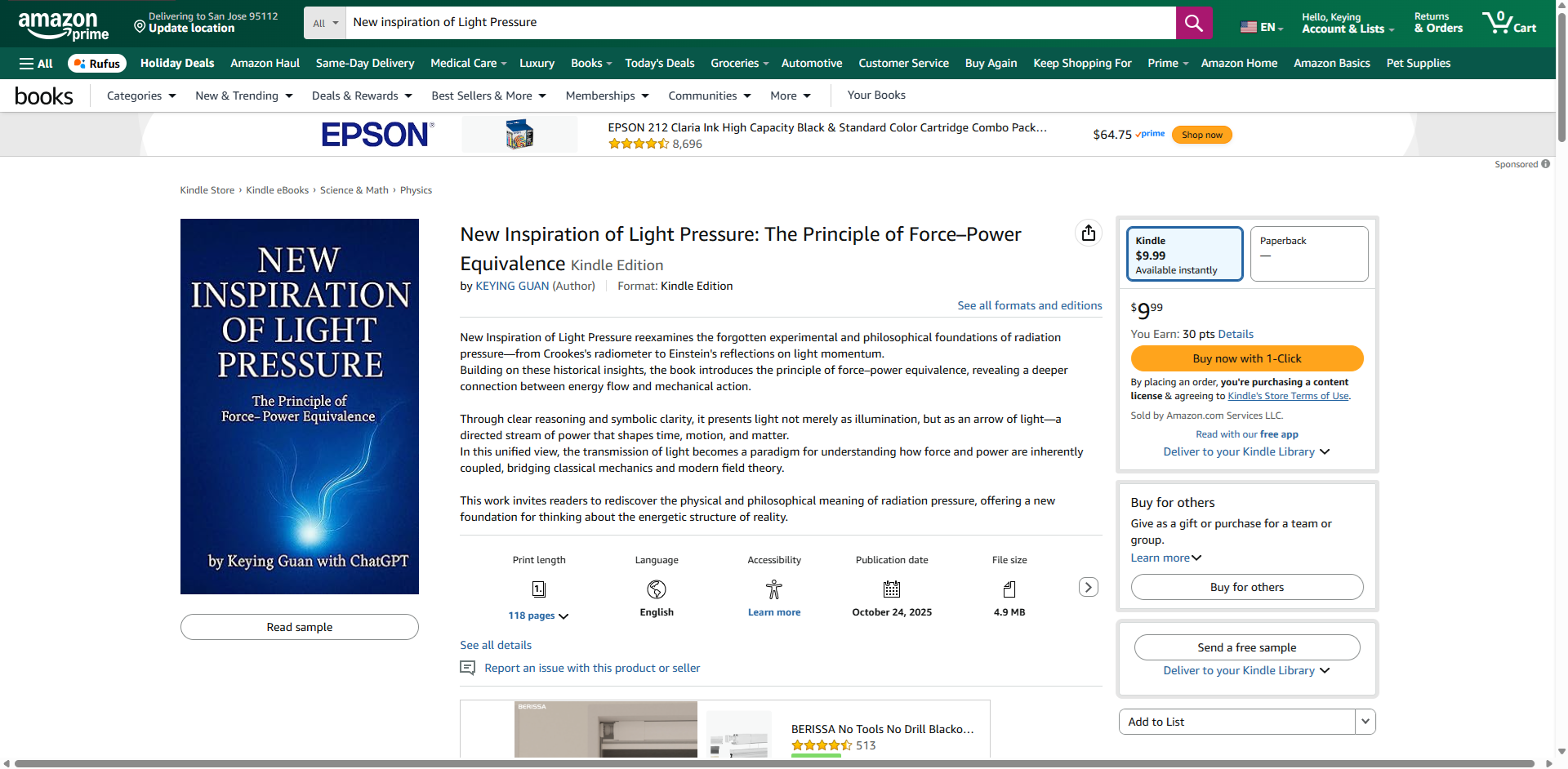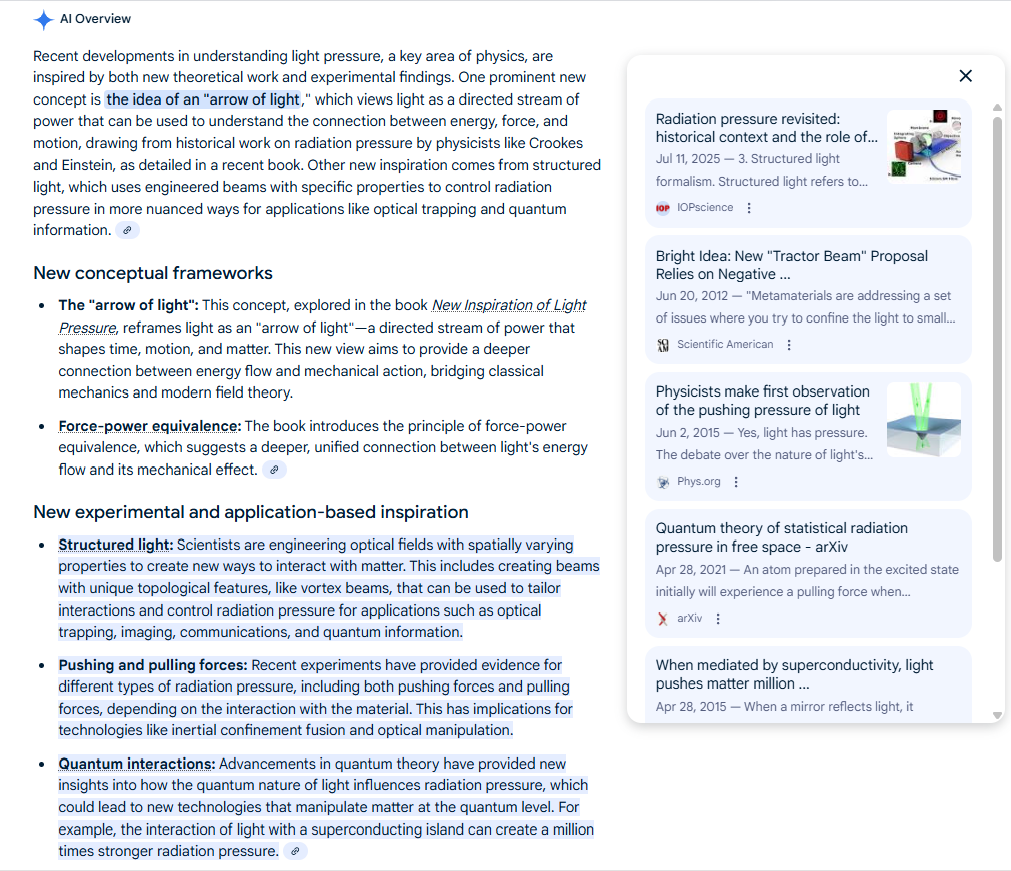New Book Announcement: New Inspiration of Light Pressure Officially Released
Introduction
We are pleased to announce the global publication of the new English book New Inspiration of Light Pressure
by Keying Guan with ChatGPT, now available in both print and eBook formats across multiple international
platforms, including BookBaby, Barnes & Noble, Amazon, Gandhi, Lehmanns, and eSentral:

Figure 1: The book's sales page on Amazon.com

Figure 2: Screenshot of search results page on global platforms
Figure 3: Cover: New Inspiration of Light Pressure (2025)

Figure 4. Human Paradox: A metaphorical depiction of the human attempt to defy
natural constraints through self-generated forces — pulling one’s own hair to fly.
This visual satire reflects the misunderstanding of passive force support without energy consideration.
Table of Contents of this book
Preface 5
Chapter 1. Historical Foundations of Work, Power, and Radiation Pressure 9
1.1 Work and Power 9
1.2 Krönig's Ideal Gas Model and Its Lasting Misinterpretations 10
1.3 Maxwell and Bartoli 11
1.4 Crookes' Radiometer 12
1.5 Poynting and the Energy Flow of Fields 13
1.6 Boltzmann and the Thermodynamic View of Radiation 14
1.7 Planck, Quantum Theory, and de Broglie 15
1.8 Lebedew's Torsion Balance 16
1.9 Einstein and the Early Quantum Insights 17
1.10 De Broglie and the Quantum Transition 17
1.11 Compton Scattering: Conservation at the Microscopic Level 17
1.12 Eddington and the Stellar Role of Radiation Pressure 18
1.13 Summary 19
Chapter 2. Research Trajectory and Theory of the Force–Power Equivalence Relation 23
2.1 Classical Formulation of Power 23
2.2 From Units to a General Expression of Power 23
2.3 Intrinsic Force 25
2.4 The Power-Force Equivalence Principle 25
2.5 Reflections on the Path to the Principle 26
2.6 The Universality of Force-Power Equivalence 28
2.7 From Averaging to Reality 30
Chapter 3. Power-Based Interpretation of Static Support 33
3.1 Static equilibrium as continuous power flow 34
3.2 Spatio-temporal representation of support power 35
3.3 Radiative loss and effective measurement 35
3.4 Transition to radiation-pressure applications Quantitative 37
Chapter 4: Toward a Revised Radiation Pressure Paradigm 39
4.1 Curl Structure, Poynting Flux, and Directed Forces 39
4.2 Correcting the Classical Formula 40
4.3 Transmission, Shadowing, and Optical Nonlinearities 41
4.4 Toward a General Framework 42
Chapter 5: Reinterpreting Experimental Evidence and Applications 45
5.1 From Crookes’ Radiometer to the First Hint of Absorbed Power 45
5.2 From Thermal Misconceptions to Lebedew’s Torsion Balance 46
5.3 From Reflective Mirrors to the Nichols–Hull Paradox 46
5.4 From Crookes to Lasers: Direct Evidence of Radiation Pressure 50
5.5 From Diverse Results to a Unified Experimental Program 52
Chapter 6: Philosophical and Theoretical Integration 55
6.1 From Newton’s Vis Insita to the Concept of Intrinsic Force 56
6.2 From Energy Dissipation to the Basis of Irreversibility 56
6.3 From Power Flow to Entropy Production 57
6.4 From Dissipative Flows to the Arrow of Time 59
6.5 From Local Irreversibility to Universal Principles 61
6.6 From Physical Law to Philosophical Reflection 61
6.7 From Dissipation to the Arrow of Time 62
Chapter 7. Toward a Unified Framework 65
7.1 From Classical Radiation to Universal Dissipation 65
7.2 From Mass–Energy Equivalence to Force–Power Equivalence 67
7.3 From Local Measurements to Cosmological Implications 68
7.4 From Theoretical Framework to Future Experiments 69
7.5 From Conceptual Unification to Open Questions 71
Chapter 8 Applications and Prospects 73
8.1 Space Engineering: Radiation Pressure in Propulsion 73
8.2 Micro- and Nano-Scale Devices 73
8.3 Atmospheric and Environmental Sensing 74
8.4 Standards and Metrology 74
8.5 Extensions to Particle Physics 74
8.6 A Conceptual “Mini Photon Rocket” 75
8.7 Looking Forward 75
Chapter 9 Conclusions and Outlook 77
9.1 Summary of Core Findings 77
9.2 Significance of the Force–Power Equivalence Principle 77
9.3 Limitations of the Present Study 78
9.4 Metrological Constant Interdependence and the Role of the Gas Law 78
9.5 Non-Ideal Boundary Conditions and Energy Exchange 79
9.6 Future Directions 80
9.7 Closing Remarks 80
Acknowledgments 83
References 85
Part I Published Literature 85
Part II. Blog Articles (ScienceNet.cn) 87
Appendix I Supplementary Videos 89
Video 1 89
Video 2 90
Video 3 91
Appendix II — On the Philosophical Significance of Experiment 92
Afterword 95

Figure 5. Photon Rocket (excerpt from Section 9.6 of this book)
Only the emission of photons creates recoil thrust; external radiation pressure contributes no net propulsion. This principle highlights the importance of internal energy flow as the source of mechanical action — a key foundation of the book’s force-power equivalence.
Two Foundational Concepts Introduced
1. The Arrow of Light
This concept redefines light not merely as illumination, but as a directed stream of power—an arrow of
light—that links energy, force, motion, and matter. This stream can exert mechanical pressure, aligning
energy flow with physical action. Inspired by the work of Crookes, Bartoli, and Einstein, the book extends
their legacy into a unified modern framework.
2. Force–Power Equivalence
A novel equivalence is proposed:
This equation suggests that even static forces, such as support or tension, represent continuous energy
consumption. Analogous to E = mc², this perspective offers a fresh lens to view gravity, inertia, and radiation
phenomena as unified expressions of power dynamics.
Endorsed by AI: Structured Light, Quantum Forces, and Beyond
An AI overview generated by web engines has already connected this book’s core ideas with cutting-edge
research, including:
Structured Light
Scientists are designing optical fields with spatially varying properties (e.g., vortex beams), enabling advanced
control over radiation pressure for applications like optical trapping, quantum computing, and communication.
(https://iopscience.iop.org/article/10.1088/1361-6455/ac9e22)
Pushing and Pulling Forces
Experimental evidence confirms that light can exert both pushing and pulling forces, depending on material
interactions—relevant for fusion technology and nanoscale manipulation.
Quantum Interactions
Quantum-level studies show that light interacting with superconducting systems can generate radiation
pressures a million times stronger than previously thought.

Figure 6: Screenshot of AI-powered automatic recommendation page
We sincerely invite readers to purchase this book through various platforms
and welcome further exchanges and discussions on the new ideas presented
in the text.
转载本文请联系原作者获取授权,同时请注明本文来自管克英科学网博客。
链接地址:https://wap.sciencenet.cn/blog-553379-1508513.html?mobile=1
收藏

